- Introduction
- Origin of Charge
- Basic Law of Charges
- Charging Materials
- The Electroscope
- Charges in Air
- Application of Electrostatic Charges
- Dangers of Electrostatics

Introduction
- This is the study of static charges. There are two types of charges i.e. negative charge and positive charge.
- When a plastic ruler is brought near to small pieces of paper, it will be noted that it cannot be able to attract the small pieces of paper. This is because the ruler is electrically neutral.
- When the ruler is rubbed against fur or hair the static charges becomes active. In this case, between the ruler and fur or hair they interchange charges whereby one becomes positively charged and the other negatively charged. Because of this the ruler is able to attract the small pieces of paper.
- The SI unit of charge is coulomb (C). Millicoulombs and micro-coulombs are also used.
1000 millicoulombs = 1 coulomb
1000000 micro-coulomb = 1 coulomb

Origin of Charge
- Matter is made up of atoms. An atom has particles known as protons, electrons and neutrons. Protons are positively charged, electrons are negatively charged and neutrons are neutral.
- Protons and neutrons are found at the centre and nucleus of the atom while electrons are found moving around the energy levels as shown
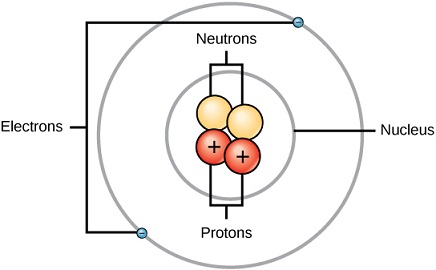
- The nucleus has positive charge due to the charges on the protons. Electrons in the outermost orbit are weakly held by the nucleus and can be transfer easily from one material to another by rubbing.
- The material that gains electrons becomes negatively charged and that which loses electrons becomes positively charged. A negatively or positively charged atom is called an ion.
- Materials like polythene and plastic acquire electrons when they are rubbed hence they become negatively charged while materials like acetate, Perspexand glass have their electrons removed from their surface when rubbed and they become positively charged.
- In general origin of charge is based on the atom of any given substance; each atom contains protons, electrons and neutrons.

Basic Law of Charges
- This law is based on the relationship between charges when they are brought near to each other. It states that unlike charges attract while like charges repel.

Charging Materials
Materials can be charged by the following methods;
- Induction
- Contact
- Separation
Induction
- This is the ability in which a body which is charged find to influence another adjacent to acquire an opposite charge.
- The figure below shows charging a single sphere by induction.
Charging by Contact
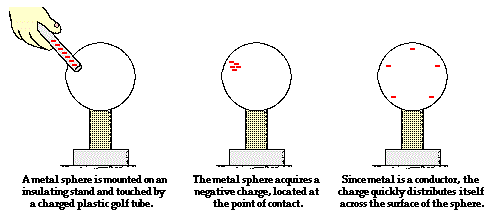
Charging by Separation
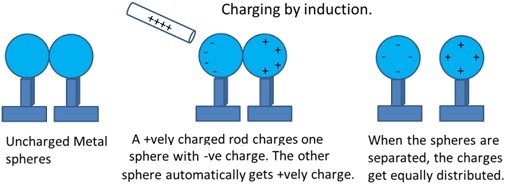
- In this case two uncharged bodies are brought near to charged material. By the process of induction the two bodies will acquire an opposite charge because of attraction and repulsion.
- The positive charge in A influence negative charges in X because of attraction while it influences positive charges in Y because of repulsion.
- NOTE: Inorder to sustain the two opposite charge in X and Y in the two bodies, they are first separated while the position in body A is maintained. Finally when they are separated the two bodies will distribute uniformly.

The Electroscope
- This is an instrument which works on the principle of electrostatic charges. It is also used for investigating the effects of electric charges.
- The gold-leaf electroscope consists of a thin gold or aluminium leaf of plate connected to a metal rod that has a brass cap at the top as shown.
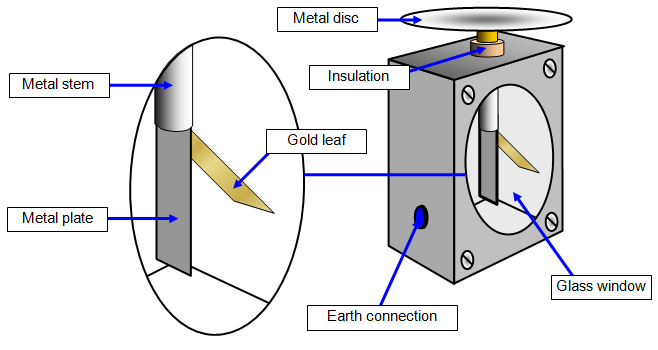
- The cap acquires the charges through induction or contact and spreads it through the rod to the plate and leaf.
- The cap is circular to ensure uniform distribution of charges. Both the leaf and the plate show the presence of charges by repelling each other, making the leaf to diverge. The absence of charges is also shown when leaf divergence decreases.
- Metal casing is for protecting the leaf from the effects of draught. The casing has a glass window through which observations are made.
- The rod is supported by passing it through a plug of good insulating material such as rubber. The insulator stops charge given to the cap from spreading onto the case and leaking away. The casing may be a terminal connected to the earth.
- When the electroscope is touched by a finger or connected to the earth by a wire, electrons either flow to the earth, depending on the charge on the electroscope.
- The process of losing to or gaining charges from the earth through a conductor is called earthing.
Charging an Electroscope by Contact Method
- In this method, a charged body is brought into contact with the cap of the electroscope.
- Because the negative charge on the rod are in contact with the negative charge at the cap, the two charges neutralise i.e. negative charges move to the rod and positive charge move to the cap.
- It will be observed that at the leaf, the leaf diverges because of like charges at the point (positive charges).
- The more positive charges at the leaf will make the leaf to diverge at a greater angle. If the process is continued, the electroscope will charge to a maximum point in which the leaf cannot diverge any further.
- NOTE: The charged material coming into contact with the cap of the electroscope is an insulator. Only charges on the rod’s surface coming into contact with the cap are used in neutralising the charges induced on the cap.
Charging Through Induction
- In this method a charged body is brought near to the cap of the electroscope and because of attraction the cap is going to have opposite charge while at the leaf is going to have same charge because of repulsion.
- The positive charges at rod attract the negative charge at the cap and repel positive charge at the leaf. The positive charges at the leaf repel one another thus making the leaf to diverge through an angle.
- In order to eliminate the charges at the leaf, one is required to earth the cap by the use of a finger or a wire while maintaining the position of the charging rod;
- Through earthing electrons are going to flow from the ground through the cap down the leaf to neutralise the positive charge hence making the leaf to fall.
- These electrons when they pass through the cap, they are not affected by the negative charge at the cap. This is because the negative charge at the cap and the positive charge on the rod are strongly attached because of attraction.
- While maintaining the position of the rod remove the finger or the earth wire first in order to avoid the negative charge at the cap not to escape down to the ground.
- Finally remove the positive charged rod away from the cap. Because of like charges at the cap they will repel one another in order to distribute uniformly on the cap and the leaf.
- The negative charges which move to the leaf diverge once more indicating electroscope has been charged.
Assignment
Use a negatively charged rod to explain how to charge an electroscope using induction method.
Uses of the Electroscope
- To detect the presence of charge on a body
The material to be tested is placed on or close to the cap of the electroscope. If it is not charged, the leaf does not diverge. - To test the sign of charge on a charged body
Charge an electroscope negatively by contact method. Slowly bring a negative rod to be tested close to the cap of the electroscope. The leaf diverges more. It does so because the negative charges on the rod repel more charges from the cap to the plate and the leaf. Similar charges in the plate and the leaf are repelled more.
When a strong positively charged rod is brought from high position towards a negatively charged electroscope, the leaf divergence first decreases then increases as the rod approaches the cap. The leaf divergence reduces slightly first because the positive on the rod attract negative charges on the leaf and plate, making the electroscope neutral. On moving the rod, much lower, the leaf divergence increases again to higher position. This is because the strong positively charged rod attracts more electrons from the plate and leaf, making
them more positive. Hence, they repel further.
NOTE: The same observations are made when a negatively charged rod is brought towards a positively charged electroscope.
On moving a neutral conductor close to a charged electroscope, leaf divergence decreases. Charges on the electroscope induce opposite charges on the conductor.
An increase in divergence of the leaf is therefore the only sure way of confirming the kind of charge on a body.Charge on the electroscope Charge brought near the cap Effect on the leaf divergence + + Increase - - Increase + - Decrease - + Decrease +or- Uncharged Decrease - To test the quantity of charge on a charged body
Small bodies have few charges compared to big ones of the same kind. - To test for insulation properties of a material
Materials like copper, iron, aluminium, zinc and graphite make the leaf divergence decrease. Materials like plastic, glass, charcoal and wood do not affect the divergence of the leaf.
For metals and graphite, the leaf decreases in divergence because they allow electrons to flow between the electroscope and the earth. Such materials are called conductors. In conductors, electrons freely move from one atom to another. Such electrons are called free electrons.
For materials like plastic, glass, wood there is no change in leaf divergence because they do not allow electrons to flow between the electroscope and the earth. In these materials, electrons are not free to move and are strongly bound to their nuclei. These materials are called insulators.
There are other materials like silicon and germanium which conduct under special conditions. This conductivity is between conductivity of insulators and conductors. Such materials are called semi-conductors.

Charges in Air
- Air can also be charged. It is shown by heating air above a charged electroscope. It is observed that the leaf divergence decreases.
- When fuel burns, chemical reactions yield ionised products. The ions move and collide with air molecules making air to be ionised. Ionisation produces both negative and positive charges.
- The ions carrying opposite charge to the electroscope are attracted to the cap of the electroscope, resulting in the discharge of the electroscope.

Application of Electrostatic Charges
- Electrostatic precipitator
It is used in industries to reduce pollutants. The figure below shows a common precipitator used in chimneys.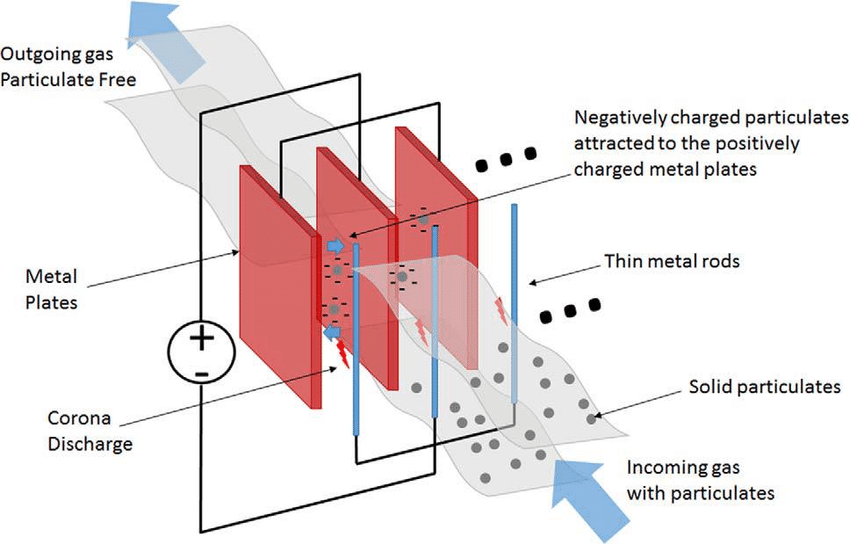
It consists of a cylindrical metal plate fixed along the walls of the chimney and a wire mesh suspended through the middle. The plate is charged positively at a potential of about 5000V while the wire mesh is negatively charged.
A strong electric field is set up between the plates, which ionises the particles of the pollutants. These are attracted to the plate. - Spray painting
The can is filled with paint and nozzle charged. During spraying, the paint droplets acquire similar charges and therefore spread out finely due to repulsion. As they approach the metallic body they induce opposite charges which in turn attract them to the surface. Therefore little paint is used. - Finger printing and photocopying

Dangers of Electrostatics
- When a liquid flows through a pipe its molecules become charged due to rubbing on the inner surface of the pipe. If the liquid is inflammable it can cause sparks and explode.
- Similarly, explosive fuel carried in plastic cans can get charged due to rubbing which may result in sparks and even explosion.
- It is therefore advisable to store fuels in metal cans so that any charges generated continually leak.
Assignment
- Explain why fuel tankers have a loose chain hanging under them to touch the ground as they move?
- Why do some motor tyres contain graphite?
Download ELECTROSTATICS 1 - Form 1 Physics Notes.
Tap Here to Download for 50/-
Get on WhatsApp for 50/-
Why download?
- ✔ To read offline at any time.
- ✔ To Print at your convenience
- ✔ Share Easily with Friends / Students


